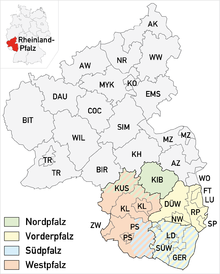Southern Palatinate
The southern Palatinate is the southern and southeastern part of the Pfalz region in Rhineland-Palatinate .
Structure and boundaries
Essentially, the southern Palatinate consists of the districts of Germersheim and Südliche Weinstrasse and the city of Landau . Because of the similar dialect , parts of the east of the district of Südwestpfalz , especially the region around Dahn , are also included.
In the north the southern Palatinate borders on the Vorderpfalz , in the east on the Rhine , in the south on the French Lower Rhine and in the west on the West Palatinate .
history
In 1809 63 or 66 families, most of whom came from the southern Palatinate, which was devastated by the Napoleonic Wars , accepted the invitation of Tsar Alexander I and emigrated to Russia , where they founded the mother colony in Landau . Most of the Palatinate families came from the districts of Germersheim , Bergzabern , Landau and Pirmasens , most of the Alsatians from the canton of Weißenburg .
Cities
The following medium-sized and small towns are located in the southern Palatinate and are listed in clockwise order:
dialect
The South Palatinate is not an independent dialect, but is only the southern variant of the Front Palatinate . What is particularly noticeable about the South Palatinate is the heavy use of the umlaut ä , which is formed from diphthongs such as ei and au . In addition, the softening of the consonant g , which is pronounced hard in the Vorderpfälzischen, to a gently sounding ch , which gives the Südpfälzischen a generally softer speech melody.
The differences between Vorderpfälzisch and Südpfälzisch are limited to the above-mentioned differences in pronunciation and the use of individual words. For example, the verb groine for crying is very common in the Upper Palatinate, while it is not used at all in the Southern Palatinate. Conversely, the South Palatinate expressions Määd for girls or naa for hin are unknown in the Upper Palatinate.
Especially in the transition area from the northern southern Palatinate to the Vorderpfalz or the southern Vorderpfalz into the southern Palatinate, both variants influence each other, and a mixed dialect can arise. In the area of the French border, echoes of the Alsatian variant of Alemannic can also be heard.
The following table shows the main differences between the southern and the northern part of the Palatinate with examples.
| Standard German | South Palatinate | Front Palatinate |
|---|---|---|
| lie | liche | liche / ligge |
| cry | haile / screech | groine |
| Wine | Wai / Woi | Woi |
| girl | Girl / girl | Girl |
| drive to |
naafahre (south of southern Palatinate beyond Karlsruhe) |
go here |
| eyes | Area | Aache / Aage |
| happiness | Freedom | Freedom |
| ask | frooche | frooche / frooge |
| woman | Frää / Fraa | Fraa |
| I | I / ech | ish |
Web links
Individual evidence
- ^ A b Karl Stumpp: The emigration from Germany to Russia in the years 1763–1862 . Ed .: Country team of Germans from Russia. 9th edition. 2009, p. 90 .
- ↑ Beresan District Odessa Newsletter. (PDF; 471 kB) (No longer available online.) June 1996, p. 4 f. , archived from the original on November 13, 2013 ; accessed on December 30, 2013 (English, edition 1.1).
- ^ Alfred Eisfeld: 200 years of settlement of the Germans in the Black Sea area. (PDF; 2.0 MB) Landsmannschaft der Deutschen aus Russia, pp. 5, 17 , accessed on December 30, 2013 .
- ^ The settlement manifesto of Alexander I. (No longer available online.) Migrationsmuseum.it, February 20, 1804, archived from the original on December 27, 2013 ; accessed on December 30, 2013 .

